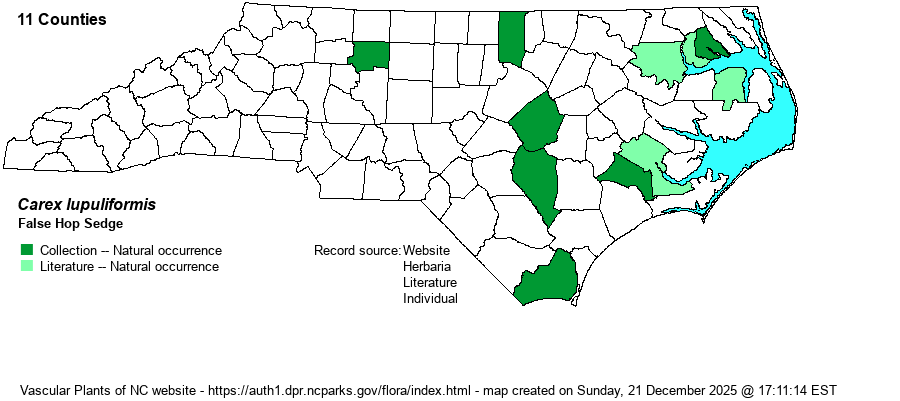| Author | Sartwell ex Dewey | |
| Distribution | Primarily central and outer Coastal Plain; other records in the Piedmont for Granville and Forsyth counties. A report of lupuliformis from Moore County (Sorrie, 2018 email) is actually of hybrids between C. lupulina and another species, probably C. lurida. Etienne Lacroix-Carignan of University of Montreal is studying this and other species in the group Lupulinae and has provided verified photos from a new population in Johnston Co.
VT, southern Que., and WI south to FL and eastern TX. | |
| Abundance | Rare in the Coastal Plain, and very rare in the northern Piedmont. Long-rhizomatous, so probably forms colonies or patches. This is a Significantly Rare species. | |
| Habitat | Openings and pools in floodplains and bottomlands, riverside marshes, streamsides. The 2022 Johnston Co. plants grew under red maple and sweetgum at border of stream that had beaver activity, with Carex gigantea, lupulina, louisianica, tribuloides. |
| Phenology | Flowering and fruiting late May-July. | |
| Identification | Similar to C. lupulina, C. gigantea, and large individuals of C. lurida; best told by its achene (seed) bodies, which are as wide as long and which possess distinct nipples or knobs at the 3 angles. In C. gigantea, the achene bodies are definitely wider than long and lack the knobs. In C. lupulina, the achene bodies are longer than wide and have no knobs. Plants with poorly developed achenes (not attaining full size or maturity) are hybrids involving C. lupulina crossing with C. lurida. | |
| Taxonomic Comments | It has been suggested that some NC specimens show differences from "normal" C. lupuliformis; additional study is being conducted by Etienne LaCroix-Carignan at Univ. Montreal.
The genus Carex is the largest in North America, and among the largest in the world. In temperate and boreal regions, Carex is often the dominant or co-dominant ground layer in many habitats. Seeds (achenes) are valuable food for birds and small mammals, while foliage is used by birds and mammals to make nests and as food by mammals. Species of Carex often look vastly different from one another -- spikes erect vs. drooping, tiny inflorescence vs. whopping, culms leafy vs. naked, perigynia beaked vs. beakless, stems densely bunched vs. single, etc. The genus has been divided into many sections (or groups), based on shared characters; some taxonomists have suggested that these be different genera, but that proves unworkable (so far). All Carex share the feature of a perigynium (an outer covering) which completely surrounds the achene (seed). This covering may fit tightly or loosely (like a small bladder), depending on which group or species. Details of perigynia shape, ornamentation, presence and size of beak, number of striations (or veins) are all important ID features. In recent years Rob Naczi and colleagues have stressed the importance of arrangement of perigynia -- whether spiral (3+ ranks) or distichous (2-ranked) -- and have named a number of new species as well as split off some older synonyms. Therefore, RAB's (1968) key, excellent for its time, can only be used in a general way today. Members of some sections of Carex are difficult to key out (notably Ovales, Laxiflorae, Griseae); this is in part due to variation among individuals of a species, or failings of the key. FNA has drawings of most species and some species may be found in two or more places within a key, to acount for variability. New species to NC, and new to science(!), continue to be found in NC. | |
| Other Common Name(s) | Hop-like Sedge | |
| State Rank | S1 [S2] | |
| Global Rank | G4 | |
| State Status | SR-P | |
| US Status | | |
| USACE-agcp | OBL link |
| USACE-emp | FACW link |

